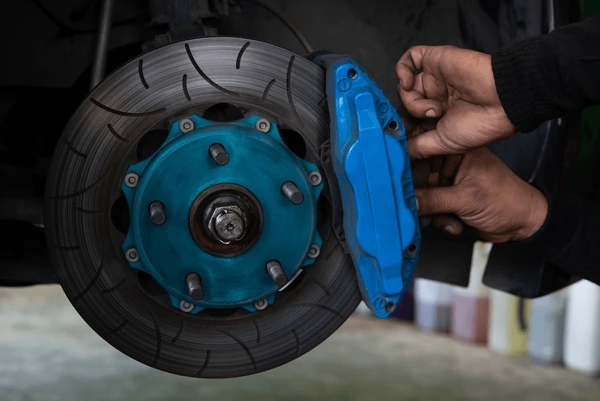Experiencing brake failure while driving can be one of the most terrifying situations a driver can face. Knowing what to do in this critical moment can mean the difference between a safe stop and a disastrous accident. This blog will walk you through the essential steps to take during a brake failure and emphasize the importance of having reliable roadside assistanceready for any emergencies.

Stay Calm and Assess the Situation
The first thing to remember during a brake failure is to stay calm. Panicking will only make the situation worse. Take a deep breath and quickly assess your surroundings. Are there other vehicles close by? Are you on a busy road or a quiet street? Understanding your environment will help you make informed decisions.
Use the Emergency Brake
Your vehicle’s emergency brake, also known as the parking brake, can help slow down the car if your regular brakes fail. Gradually pull up on the emergency brake lever or press the emergency brake button (in some newer cars), ensuring you do so slowly to avoid locking up the wheels, which can cause the car to skid.
Downshift to Lower Gears
If you drive a manual transmission, downshift to lower gears to help the engine slow the car. For automatic transmissions, manually shifting to lower gears (like ‘L’ or ‘2’) can also help reduce speed. This process, known as engine braking, uses the resistance of the engine to slow the vehicle down.
Pump the Brake Pedal
In some cases, especially with older vehicles or those with drum brakes, pumping the brake pedal might build enough hydraulic pressure to get the brakes working again. Rapidly pump the brake pedal and see if you regain any braking power.
Warn Other Drivers
It’s crucial to alert other drivers that you are having an emergency. Turn on your hazard lights and, if necessary, use your horn to signal that something is wrong. This can help prevent collisions by making others aware of your situation.
Find a Safe Place to Stop
Look for a safe place to pull over, such as an emergency lane, shoulder, or a flat, open area away from traffic. Avoid steep hills or sharp curves where it might be harder to control the vehicle.
Use Roadside Assistance
Having reliable roadside assistance can be a lifesaver during brake failure. Roadside assistance services can provide immediate help, from towing your vehicle to a safe location to arranging for repairs. If you experience brake failure and manage to bring your car to a stop, call your roadside assistance provider right away. They can guide you through the next steps and ensure your vehicle is safely towed to a repair shop.
Preventive Measures and Maintenance
To minimize the risk of brake failure, regular maintenance is crucial. Here are some preventive measures:
Regular Brake Inspections:Schedule regular brake inspections to catch any potential issues before they become serious. Most mechanics recommend a brake check every six months.
Brake Fluid Check:Ensure your brake fluid is at the correct level and free from contamination. Low or dirty brake fluid can lead to brake failure.
Listen for Unusual Noises:Pay attention to any unusual noises when you apply the brakes, such as grinding or squealing. These sounds can indicate worn brake pads or other issues.
Notice Changes in Pedal Feel:If your brake pedal feels soft or spongy, it might be a sign of air in the brake lines or a problem with the brake master cylinder.
The Role of Roadside Assistance
Having a reliable roadside assistance plan can make a significant difference during a brake failure incident. Roadside assistance providers offer a range of services, including:
Towing Services:If your brakes fail and you cannot safely drive the car, roadside assistance can tow your vehicle to a repair shop.
Emergency Repairs:Some roadside assistance services can perform minor repairs on the spot, helping you get back on the road safely.
Battery and Fuel Assistance: Roadside assistance can also help with other issues, such as a dead battery or running out of fuel.
Choosing the Right Roadside Assistance Plan
When selecting a roadside assistance plan, consider the following:
Coverage Area:Ensure the plan covers the areas where you frequently drive.
Services Offered:Check what services are included, such as towing, fuel delivery, and emergency repairs.
Cost:Compare the cost of different plans to find one that fits your budget while providing the necessary coverage.
Reputation:Look for reviews and testimonials from other customers to gauge the reliability and quality of the roadside assistance provider.
Final Tips for Brake Failure Preparedness and Roadside Assistance
Remember to use the emergency brake, downshift to lower gears, and signal to other drivers. Most importantly, having a dependable roadside assistance plan can provide peace of mind and immediate help in such emergencies. Regular vehicle maintenance and preventive measures can reduce the risk of brake failure, ensuring a safer driving experience. Stay prepared, stay calm, and always have roadside assistance on speed dial.
FAQ
What should I do immediately if my brakes fail while driving?
If your brakes fail, stay calm. Remove your foot from the accelerator and turn on your hazard lights to alert other drivers. Try to pump the brake pedal rapidly to see if you can build up enough pressure to stop. If that doesn’t work, downshift to a lower gear to help slow down your vehicle gradually.
How can I safely bring my vehicle to a stop without brakes?
If pumping the brakes doesn’t work, use your emergency brake (parking brake) cautiously. Apply it slowly and steadily to avoid locking the wheels. If the emergency brake fails, steer your vehicle to the side of the road, preferably an open area, and let friction slow you down. Use natural road features like an incline or soft shoulder to help reduce speed.
